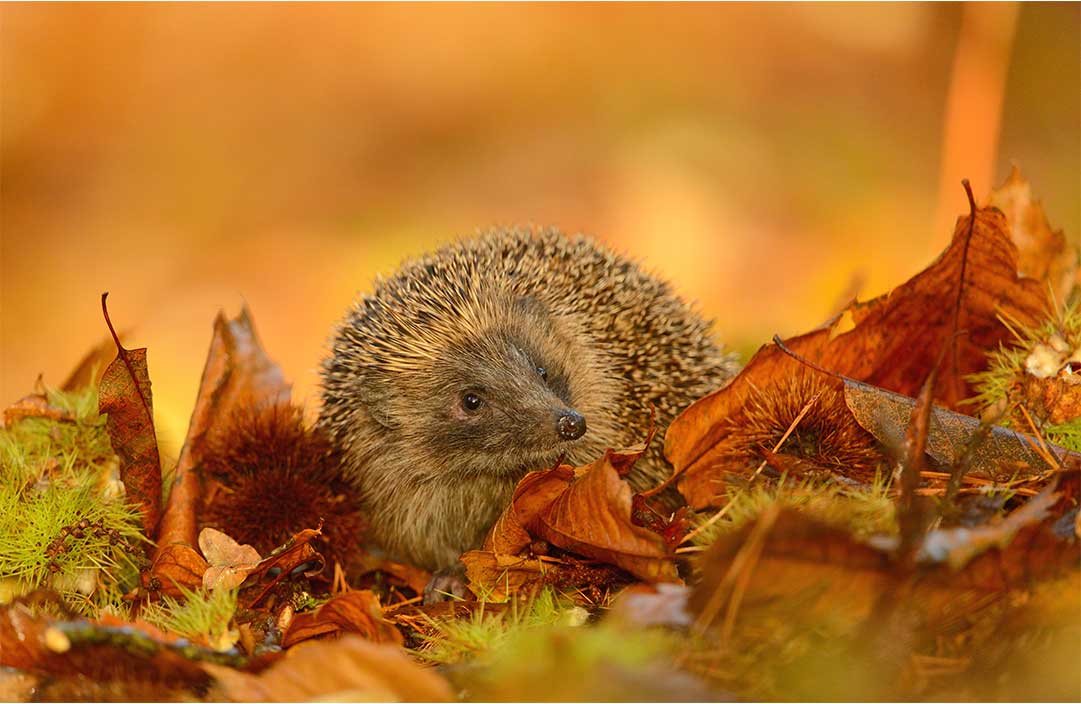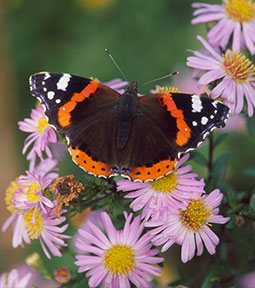10 ways to support the wildlife in your garden this autumn
As the nights begin drawing in, a slight chill fills the air and the leaves start to turn to vibrant hues of yellow and red, the wildlife around us prepares to hunker down for the winter. Hedgehogs, bats and Dormice get ready to hibernate, whilst other animals like Badgers, frogs and Red Squirrels prepare to slip into a state of ‘torpor’, which is basically a much less intense form of hibernation.
Because of this, autumn is such an important time of the year to support your local wildlife. There are so many simple ways you can help birds, Hedgehogs, insects and bats get through the tough chilly months ahead, all from the comfort of your own garden.

Credit: Ben Andrew (rspb-images.com)
Take a look at our top tips to support wildlife in your garden this autumn.
1. Get planting
While you might think it’s time to hang up your gardening gloves for the year, autumn is actually the perfect time to keep those green fingers busy. Sow some RSPB wildflower seeds to create your very own wildflower meadow, perfect for attracting an abundance of bees, butterflies and more when spring rolls around.
It’s also a great time to prepare for bare root tree, shrub or rose planting, which should happen from November onwards. Opt for shrubs with berries to attract and support even more wildlife.
2. Create a haven for Hedgehogs
Hibernation season is fast approaching for our prickly friends, so now is a great time to offer your friendly neighbourhood Hedgehog a cosy spot to rest and replenish. Place a Hedgehog house in a quiet, shady area, ideally under some bushes or against a fence or wall. At RSPB Shop we have a couple of options available when it comes to Hedgehog homes – choose from the Silhouette Hedgehog home or the Classic Hedgehog home – both of which provide the perfect safe haven for Hedgehogs.
Another way to help hedgehogs this autumn is to provide them with food and water. As all wildlife begins to wind down for the year, it can be harder for ‘hogs to find food, so popping out a bowl of Brambles crunchy Hedgehog food or Semi-moist Hedgehog food can be a great help. Of course, always supply fresh water too, and make sure food and water containers are regularly refreshed and cleaned.
3. Put up nest boxes
Autumn is the perfect time to clean out old nest boxes and pop any new ones up – whilst birds won’t use them for nesting until the next year, they may shelter in them as the temperature begins to drop. The RSPB Cabin nest box is both beautiful and practical – it'll provide birds with a safe and secure place to nest while looking great in your garden.
4. Install a bug hotel
While we immediately think of cute critters such as Hedgehogs and Dormice when it comes to supporting wildlife in autumn, we can’t forget about insects! Minibeasts like spiders, ladybirds and bees need somewhere cosy to shelter when the weather turns cooler, so by placing a bug hotel or bee home in your garden you’ll be lending them a helping hand. Our Dewdrop bug and bee biome will look great on display in your garden too.
5. Stock your bird feeders with energy-rich food
As temperatures begin to fall, birds need food rich in energy and fat in order to keep warm. Suet is a great option for birds at this time of year – our Super suet contains more fat than our standard suet, and is made in the UK using high-quality ingredients, with no cheap fillers. Place some Super suet fat balls into a suet feeder and watch as the birds come flocking. We also have Super suet pellets, cakes and blocks available. Make sure to put fresh food out and regularly clean the feeders. Take a look at our hygiene and safety section for more information and cleaning tips.
6. Add a pond
Autumn is a great time to build a pond, as the earth can be much easier to dig at this time of year. It shouldn’t take too long to build a small pond in your garden, and it’ll become a vital source of water for wildlife. We have three different sized pond liner kits available at RSPB Shop, which come with a guide on creating the perfect wildlife pond.
7. Try composting
Placing a compost heap in your garden is a relatively low-effort way to help support wildlife. Hedgehogs, bugs and bees will all benefit from the addition of a compost pile. A compost bin made from slatted wood is ideal as it means wildlife can get in and out easily – just make sure you don’t add anything like meat, dairy products or pet waste to your compost bin. Take a look at our guide to composting.
8. Install a bat box
It wouldn’t be autumn without bats, and due to factors including climate change and loss of habitat, there are less and less places for bats to nest available. So, why not install a bat box in your garden to provide them with somewhere to shelter? A bat box will provide them with a safe place to raise their pups, sleep during the day and hibernate throughout the winter. During summer bats like boxes in warm and sunny spots, as high as possible to raise their young. During winter, they prefer cooler spots.
9. Provide shelter for frogs and toads
Don’t forget about our amphibian friends when autumn rolls around – they need shelter from the cold too, and our Eco frog and toad house is ideal for this. Made from 100% recyclable NPLAS material (a combination of Polypropylene, natural elements and recycled second life material), it's a great eco-friendly home for frogs and toads.
10. Embrace a wild garden
Autumn is the perfect time of year to let your garden grow a little wild. Keep seed heads intact as they’ll provide an important food source for birds as well as a shelter for insects. Rake up any fallen leaves and place them in piles in the corners of your garden or behind your shed, for Hedgehogs and other wildlife to shelter in.
So there you have it – our guide to lending garden wildlife a helping hand this autumn. How are you planning on supporting wildlife this season?
